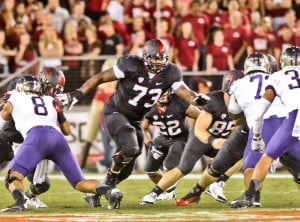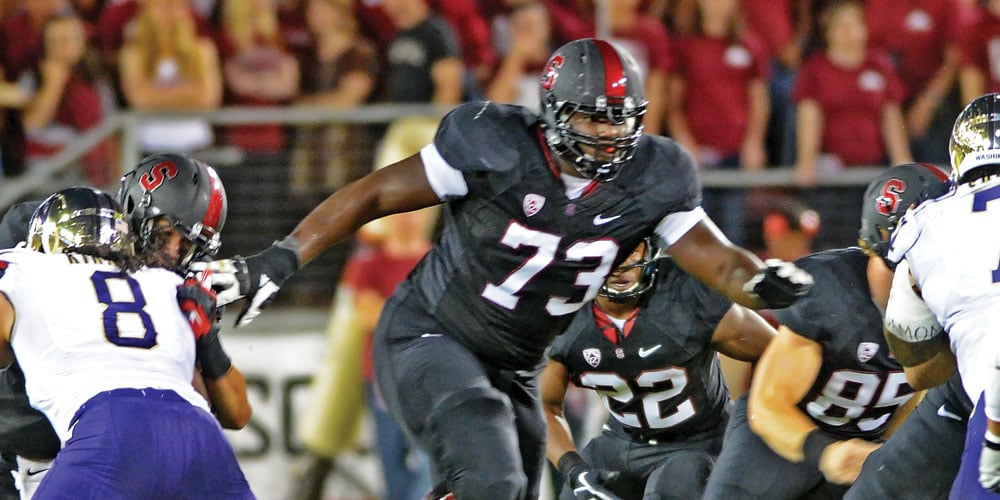Last week, the roundtable talked about which new Stanford football recruit would make the biggest immediate impact at the collegiate level. This week, we’ll take it one step farther as we ask football writers Joseph Beyda, Michael Peterson and Vihan Lakshman: which departing Stanford football player is primed to make the biggest immediate impact at the professional level next season?
Joseph: “Impact” is a funny word. For one, I’m tempted to pick Cameron Fleming, given the one-year trend for former Cardinal tackles to have a monumental (albeit unintentional) impact on the NFL.

Many mock drafts have Fleming listed as the first Stanford player off the board, though, so I’d be utterly remiss to bring up the three-year starter without giving him his due credit. Leaving the film work to those much more qualified than myself, it seems that the scout on Fleming is that his size and power will serve him well in the NFL, but that his mobility might not stack up against that of the talented tackles he’ll be competing against for playing time, possibly forcing him to move away from the position he has anchored on the Farm.
Yet I hesitate to bet against the most experienced member of an offensive line that only took two holding penalties in the regular season last year, and that averaged a paltry 1.15 sacks per Fleming start over the last three seasons. When it comes to agility, Fleming already has shown progress, improving his vertical jump by two inches in the four weeks between the NFL Combine and Stanford’s pro day. And Fleming should blow away the competition when it comes to picking up whatever the next level throws his way. Don’t forget, he’s literally a rocket scientist.
Michael: Fleming and David Yankey will likely be the first two Stanford players picked in the draft, but I like Ed Reynolds’ chances at succeeding early in his NFL career.
After Reynolds’ wildly successful junior year, he was projected to be the first safety taken in the 2013 NFL Draft, potentially in the first round, had he declared and left Stanford. However, after a “down” statistical season, Reynolds dropped to a fourth-round projection, according to CBS Sports. The supposedly down year, in my opinion, was due more to the respect other teams showed in throwing away from Reynolds (targeting the cornerbacks instead) than to poor performance.
Reynolds possesses the ball-hawking skills necessary to disrupt opposing quarterbacks, having recorded six interceptions his junior year. At 6-foot-2, he also has the size to cover tight ends from the safety position — obviously not matching tight ends in height, but you won’t see a much bigger safety. What he lacks in speed he makes up for in physicality, constantly stepping in for the big hit and providing an extra run stopper in the secondary.
In the right situation with another reliable safety, maybe with a team like Green Bay, which needs a free safety to complement strong safety Morgan Burnett, Reynolds could thrive if he’s given the freedom to range throughout the secondary like he had at Stanford. I could see Reynolds turning into a dynamic starter fairly quickly.
Vihan: This is a very tough question to answer at this point in time because the chances of any Stanford prospect making an immediate impact depend a lot on the specific system of the team that drafts him as well as the caliber of players he will have to compete against to earn playing time. Trent Murphy is a great example because he could be drafted as a defensive end in a 4-3 scheme or as an outside linebacker in a 3-4 (which he played at Stanford). Nevertheless, in spite of the uncertainty regarding his future position, I think Murphy is primed to make the biggest impact because of his pass-rushing skills and ability to play special teams.
Murphy’s stock has slipped in the pre-draft process significantly: He has gone from being a potential first round pick to a likely fourth-rounder. While his NCAA-leading 15 sacks last season speak for themselves, many scouts and executives feel that Murphy lacks the athleticism and explosiveness necessary to become an NFL starter. However, Murphy makes up for any perceived lack of athleticism with his extremely high football intelligence and his array of subtle pass-rushing moves. There are very few, if any, teams with too many pass rushers. With the NFL becoming an increasingly pass-happy league, there should be a demand for Murphy’s services and he has shown that he can deliver in big-time situations.
Furthermore, Murphy could make an impact on Sundays as a special teams player if he does not earn a starting spot on defense. With his long reach and ability to get into the backfield, Murphy could thrive on the field goal block unit, as he did on the Farm. With this added dimension that he can bring to an NFL team, Murphy clearly has the inside track to make the biggest impact right away out of all the Stanford prospects in the 2014 Draft.
Joseph Beyda, Michael Peterson and Vihan Lakshman still aspire to make the big leagues someday. Give them some training tips at jbeyda ‘at’ stanford.edu, mrpeters ‘at’ stanford.edu and vihan ‘at’ stanford.edu.
